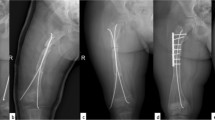Abstract
Introduction
Delay in presentation and surgical intervention is quite usual in osteogenesis imperfecta (OI) because of various local and cultural beliefs. The purpose of this study is to review the results of 21 children who had intramedullary rodding and its effect on ambulation and refracture.
Methods
We reviewed 21 children with a clinical diagnosis of OI. The mean age of children at presentation was 8.74 years (3–21 years). All children had recurrent fractures of long bones. Twenty eight femurs and 21 tibiae were stabilized with intramedullary rodding. Ambulatory status was assessed by the Hoffers and Bullock’s (H and B) grading, and muscle power was recorded using the Medical Research Council, U. K., grade. Ten children had received intravenous bisphosphonates preoperatively Postoperatively, the children were assessed for ambulatory status, pain, and ability for independent self-care.
Results
The mean followup period was 34 months (24–18 months). Rush rods were used in 20 femurs, the Fassier-Duval (FD) rods in 6 femurs, and in two cases, with narrow intramedullary canals, Kirshner (K) wires were used. For the tibiae, 15 children received rush rods and in 6 cases, an FD rod was used. The mean time to fracture union was 8 weeks (6-12 weeks). Before surgery, 13 children were in H and B Grade 4 (wheel-chair independent or carried by parents usually in a developing country), four were able to ambulate with a walking aid (H and B Grade 3b), and four children were able to walk about in the house without aids (H & B Grade 2). After the rodding procedure, the ambulatoty status improved in 11 (50%) children. Seven children (33%) became household physiologic walkers (H & B Grade 3b), three achieved independent ambulation with orthosis (H & B Grade lb), and one child with mild OI could walk unaided (H & B Grade la). No child had deterioration in ambulatory status. Only two children had refractures at the distal end of the rod due to continual growth of bones.
Conclusions
Intramedullary rodding treatment for recurrent fractures in children with OI improves their mobility potential. It also and prevents repeated cast application, disuse wasting, and osteopenia which can lead to deterioration in the quality of the long bones.
Similar content being viewed by others
References
Sykes B, Ogilvie D, Wordsworth P, Wallis G, Mathew C, Beighton P, et al. Consistent linkage of dominantly inherited osteogenesis imperfecta to the type I collagen loci: COL1A1 and COL1A2. Am J Hum Genet 1990;46:293–307.
Paterson CR. Osteogenesis imperfecta and other heritable disorders of bone. Baillieres Clin Endocrinol Metab 1997;11:195–213.
McLean KR. Osteogenesis imperfecta. Neonatal Netw 2004;23:7–14.
Rowe DW, Shapiro JR. Osteogenesis imperfecta. In: Avioli LV. Krane SM, editors. Metabolic Disease and Clinically Related Disorders. San Diego: Academic Press; 1998. p. 651–95.
Sousa T, Bompadre V, White KK. Musculoskeletal functional outcomes in children with osteogenesis imperfecta: Associations with disease severity and pamidronate therapy. J Pediatr Orthop 2014;34:118–22.
Sillence DO, Senn A, Danks DM. Genetic heterogeneity in osteogenesis imperfecta. J Med Genet 1979;16:101–16.
Van Dijk FS, Pals G, Van Rijn RR, Nikkels PG, Cobben JM. Classification of osteogenesis imperfecta revisited. Eur J Med Genet 2010;53:1–5.
Barnes AM, Carter EM, Cabral WA, Weis M, Chang W, Makareeva E, et al. Lack of cyclophilin B in osteogenesis imperfecta with normal collagen folding. N Engl J Med 2010;362:521–8.
van Dijk FS, Cobben JM, Kariminejad A, Maugeri A, Nikkels PG, van Rijn RR, et al. Osteogenesis imperfecta: A review with clinical examples. Mol Syndromol 2011;2:1–20.
Warman ML, Cormier-Daire V, Hall C, Krakow D, Lachman R, LeMerrer M, et al. Nosology and classification of genetic skeletal disorders: 2010 revision. Am J Med Genet A 2011;155A: 943–68.
Gajko-Galicka A. Mutations in type I collagen genes resulting in osteogenesis imperfecta in humans. Acta Biochim Pol 2002;49:433–41.
Roughley PJ, Rauch F, Glorieux FH. Osteogenesis imperfecta – Clinical and molecular diversity. Eur Cell Mater 2003;5:41–7.
McEwing RL, Alton K, Johnson J, Scioscia AL, Pretorius DH. First-trimester diagnosis of osteogenesis imperfecta type II by three-dimensional sonography. J Ultrasound Med 2003;22:311–4.
Kocher MS, Shapiro F. Osteogenesis imperfecta. J Am Acad Orthop Surg 1998;6:225–36.
Shi CG, Zhang Y, Yuan W. Efficacy of bisphosphonates on bone mineral density and fracture rate in patients with osteogenesis imperfecta: A systematic review and meta-analysis. Am J Ther 2016;23:e894–904.
Abulsaad M, Abdelrahman A. Modified sofield-millar operation: Less invasive surgery of lower limbs in osteogenesis imperfecta. Int Orthop 2009;33:527–32.
Porat S, Heller E, Seidman DS, Meyer S. Functional results of operation in osteogenesis imperfecta: Elongating and nonelongating rods. J Pediatr Orthop 1991;11:200–3.
Brunelli PC, Frediani P. Surgical treatment of the deformities of the long bones in severe osteogenesis imperfecta. Ann N Y Acad Sci 1988;543:170–9.
Joseph B, Rebello G, Kant BC. The choice of intramedullary devices for the femur and the tibia in osteogenesis imperfecta. J Pediatr Orthop B 2005;14:311–9.
Sofield HA, Millar EA. Fragmentation, realignment and intramedullary rod fixation of deformities of the long bones in children: A ten-year appraisal. J Bone Joint Surg Am 1959;41:1371–91.
Gerber LH, Binder H, Weintrob J, Grange DK, Shapiro J, Fromherz W, et al. Rehabilitation of children and infants with osteogenesis imperfecta. A program for ambulation. Clin Orthop Relat Res 1990;257:254–62.
Hoffer MM, Bullock M. The functional and social significance of orthopedic rehabilitation of mentally retarded patients with cerebral palsy. Orthop Clin North Am 1981;12:185–91.
Marafioti RL, Westin GW. Elongating intramedullary rods in the treatment of osteogenesis imperfecta. J Bone Joint Surg Am 1977;59:467–72.
Author information
Authors and Affiliations
Corresponding author
Rights and permissions
About this article
Cite this article
Bhaskar, A.R., Khurana, D. Results of Rodding and Impact on Ambulation and Refracture in Osteogenesis Imperfecta: Study of 21 Children. JOIO 53, 554–559 (2019). https://doi.org/10.4103/ortho.IJOrtho_202_18
Published:
Issue Date:
DOI: https://doi.org/10.4103/ortho.IJOrtho_202_18




